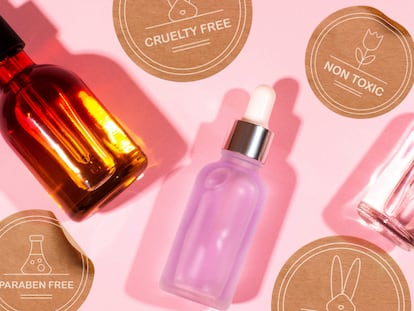Energy drinks do not give you wings: A cocktail of sugar and caffeine with health risks
Scientific evidence advises against consuming them, and nutrition professionals want a cap on the legal caffeine content

Everybody knows how difficult exam season can be. That is why it is common to see libraries full of students eager for any extra boost. In college cafeterias, this comes in the form of energy drinks. Available in various sizes and flavors, they promise to keep you awake, to improve physical performance at the gym, and to extend your nighttime endurance if you mix them with alcohol. And all for around a couple of dollars.
Children, teenagers and young adults (as is usually the case with ultra-processed foods and sugary drinks) are once again the most exposed, vulnerable and unprotected groups. In 2013, a study carried out by the European Food Safety Authority (EFSA) warned of the problem: 16% of children (three to 10 years old) consumed energy drinks on a regular basis, defined as between four and five times a week (or more), which is equivalent to two liters a month.
Studies have shown that boys are more likely than girls to consume these drinks. There is also a social component involved: a 2022 study conducted in the United Kingdom found that “adolescents from more deprived areas and lower income households were more likely to consume energy drinks than those in more affluent areas and households.” And in Spain, according to the ESTUDES survey, conducted among the 14-to-18-year-old population, 45% of teens reported having drunk this type of beverage in the last month.
Energy drinks have a high content of caffeine and sugar (its two main ingredients), and other stimulants. They have practically zero nutritional value. A 250 milliliter can of the leading brand contains 80 milligrams of caffeine. Following the EFSA recommendations on the safe intake of caffeine, the maximum amount should not exceed 3 milligrams per kilogram of a person’s weight. That is, 150 milligrams for a 50-kg teen. Each 500-milliliter can of Monster already contains 160 milligrams and more.
As for sugar, energy drinks usually provide between 27.5 and 60 grams per 250 milliliters and 500 milliliters, respectively. That is the equivalent of 11-12 teaspoons of sugar, or about 220-240 kilocalories, for each 500-milliliter container. In fact, most brands have already brought out “light” options that reduce these amounts of sugar and replace them with sweeteners.
Despite its energizing promises, the rest of its components have not been proven to have any benefits. However, what most studies do conclude is that consumption of these drinks (especially in large quantities or mixed with alcohol) has negative effects on physical and mental health. For example, cardiovascular and neurological risks, psychological problems or behavioral and sleep disturbances.
An added problem is that it is common to combine these drinks with alcohol. And by masking the depressant effects of alcohol, which would normally make the consumer feel sleepy and tired, the risk of alcohol poisoning increases.
Studies have shown that most people are unaware of the composition of energy drinks, or what their possible side effects are. For this reason, a growing number of nutrition professionals (including public figures such as the British chef Jamie Oliver) are advocating regulation to restrict the maximum caffeine content. They are also demanding greater control of advertising aimed at children and adolescents, and banning its sale to children under 16 years of age.
In Spain, authorities announced a set of measures in 2021 that ended up becoming a list of 10 recommendations developed in conjunction with the energy drink industry itself. This decalogue warns about the health risks of these drinks, advises against their consumption by adolescents, warns athletes that they are not useful for rehydration, and reminds manufacturers of their obligation to include a label indicating their high content in caffeine, therefore making them unadvisable for children and for pregnant or breastfeeding women.
Sign up for our weekly newsletter to get more English-language news coverage from EL PAÍS USA Edition
Tu suscripción se está usando en otro dispositivo
¿Quieres añadir otro usuario a tu suscripción?
Si continúas leyendo en este dispositivo, no se podrá leer en el otro.
FlechaTu suscripción se está usando en otro dispositivo y solo puedes acceder a EL PAÍS desde un dispositivo a la vez.
Si quieres compartir tu cuenta, cambia tu suscripción a la modalidad Premium, así podrás añadir otro usuario. Cada uno accederá con su propia cuenta de email, lo que os permitirá personalizar vuestra experiencia en EL PAÍS.
¿Tienes una suscripción de empresa? Accede aquí para contratar más cuentas.
En el caso de no saber quién está usando tu cuenta, te recomendamos cambiar tu contraseña aquí.
Si decides continuar compartiendo tu cuenta, este mensaje se mostrará en tu dispositivo y en el de la otra persona que está usando tu cuenta de forma indefinida, afectando a tu experiencia de lectura. Puedes consultar aquí los términos y condiciones de la suscripción digital.
More information
Archived In
Últimas noticias
Most viewed
- Sinaloa Cartel war is taking its toll on Los Chapitos
- Oona Chaplin: ‘I told James Cameron that I was living in a treehouse and starting a permaculture project with a friend’
- Reinhard Genzel, Nobel laureate in physics: ‘One-minute videos will never give you the truth’
- Why the price of coffee has skyrocketed: from Brazilian plantations to specialty coffee houses
- Silver prices are going crazy: This is what’s fueling the rally











































